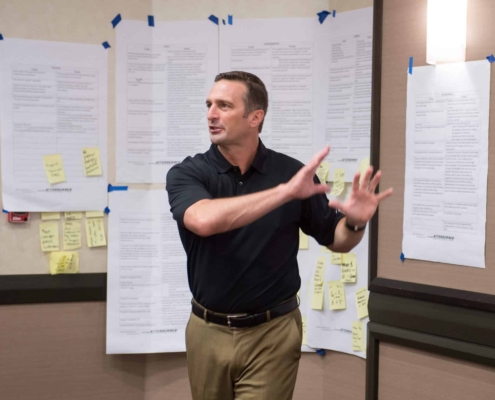 https://www.afterburner.com/wp-content/uploads/2024/09/leadership-symposium-afterburner.png
1050
1832
Nate Riggins
/wp-content/uploads/2024/07/Afterburner-Logo-Resize-Fullcolor-300x93.png
Nate Riggins2024-01-26 15:53:082024-10-23 10:53:39Decoding the 3 Crucial Leadership Situations
https://www.afterburner.com/wp-content/uploads/2024/09/leadership-symposium-afterburner.png
1050
1832
Nate Riggins
/wp-content/uploads/2024/07/Afterburner-Logo-Resize-Fullcolor-300x93.png
Nate Riggins2024-01-26 15:53:082024-10-23 10:53:39Decoding the 3 Crucial Leadership Situations
“. . . all we need to do is make sure we keep talking.”
– Steven Hawking
(performing in the Pink Floyd song, Keep Talking)
Talking. The way we humans communicate – and how we are able to record the ideas we communicate – has enabled our species to progress from hurling rocks at saber-tooth tigers to launching spaceships to other worlds. But, hurling words or social media posts at each other isn’t necessarily good communication. Recent social and neurological research has begun to pull back the curtain on the mysterious world of human communication beyond mere words. Communication is a tremendously complex activity.
So, how do we make it simple enough to put in a checklist? Well, the most effective way to improve communication is to provide some organization to it. In this article, I’ll treat how leaders organize communication. In the next article, I’ll treat ‘organization’ as its own subject and orient it toward team structures. Then, in the final article of this series, I will touch on how leaders can nurture better team communication. Communication touches every part of The Leadership Checklist.
The first items on the communication checklist concern alignment. Good leaders consistently communicate the purpose and values of the organization; how the task at hand relates to that purpose and values; and how it all aligns to strategic and long-range organizational goals (what we call the High-Definition Destination or HDD). Making these simple connections frames the ‘big picture’ – the first step in the briefing process – one of the four fundamental activities of the Flawless Execution Cycle.
Research shows that as much as 80% of communication is non-verbal. In other words, we convey much information through tone, physical gestures, and facial expressions that should be considered, for good or ill, when communicating. So, assigning communication channels, whether those channels are through telephones, e-mails, memos, or face-to-face meetings and defining what kinds of communication should take place through those channels need to be established up front.
Correspondingly, you need to have an accepted and clearly understood language. It’s okay to use jargon. In fact, jargon can aid in clear communication. Militaries have a rich lexicon of terminology that is alien to the civilian community and even different military branches. Yet, they use such jargon to great effect. But, everyone on the team needs to know the definitions of those words. Ground your communication with a standard lexicon.
Reinforce Organizational Identity
If you have been hiding under a rock and did not witness one of the thirty-seven million views of Simon Sinek’s Start With Why talk on TED.com, let me bring you up to speed. Success begins with everyone understanding the purpose of the organization or team and how their actions align with that purpose. Do you have a written organizational imperative (purpose)? Do you have a written list of organizational principles (values)? Writing them down is just the first step. The much more difficult task is making them real. Leaders have to constantly remind their teams and organizations what those imperatives and principles are in both word and deed.
Actions: Define, in simple terms, your organization/team’s purpose or reason for being. What do you exist to do? What dent are you making in the universe? Communicate that frequently. Socialize it. Quiz your team about it. Ask them what it means to them. Share with each other how meaningful it is.
Explain/Articulate the Big Picture
Do the people on your team, or many layers below you in the org chart, know why what they are doing today, tomorrow, and the next day is important? Are they taking actions that they may believe are in the best interest of the organization, but undermining organizational purpose and goals because they don’t clearly understand what those are? This sort of disconnect is not uncommon in organizations because leaders often fail to communicate how individual actions yield organizational results. As a leader it’s your responsibility to connect the myriad activities of your team to organizational goals and purpose.
Actions: Make sure your organization’s identity and HDD are written down; are not just pretty words that have no real, compelling significance; are easily found and referenced by anyone in the organization; and are communicated by you, the leader, in some form on a daily basis.
BRIEF Every Plan
Briefing is an essential form of team communication. Beyond simply reviewing the plan and everyone’s tasks, briefing succinctly and efficiently gets the team aligned and informed. If, as a leader, you are facilitating collaboration in the development of plans, briefing provides a critical transition from the deliberative and open discussions that support good planning to the execution phase where it’s time to get things done. It lets everyone know that it’s time to stop talking about what the team is going to do where everyone’s opinion is valued, to a new phase in which everyone owns their accountable actions and is expected to execute them as planned. Regardless of differing opinions in the planning phase, the brief signals an end to deliberation and the beginning of unified execution.
Actions: Use the B.R.I.E.F. acronym to structure your briefs. It follows intuitively from the planning structure that we use in Flawless Execution. B – brief the scenario, what’s the big picture and how does the plan align with the strategy, HDD, and purpose of the organization/team; R – review the mission objective; I – identify the top threats and resources; E – execution, what’s the who does what when of the course of action; F – flexibilities, what are the contingency plans.
Establish a Communication Plan
Communication is essential. Miscommunication can be disastrous. Too much communication can be Task Saturating. How you organize and establish a disciplined means of communication can make a big difference. Creating a communication plan is essential in high-risk, rapidly changing, and complex undertakings like military operations. Most businesses can benefit from a communication plan that details who, what, when, and how different forms of communication and information flow will be executed.
Actions: What channels do you have available to you for communication – e-mail, text, telephone, voicemail, teleconference, etc.? Will you use different or multiple channels for different communication purposes? What will be the format of written communication? Will you have a formal communication plan that explains what is to be communicated; to whom it should be addressed; how it should be prioritized; and through what channel or channels it should be transmitted?
Utilize Common Language
Ambiguity undermines execution. Clarity is essential to success. Ambiguity of meaning can have disastrous consequences if communication is misunderstood. How important is clear and unambiguous language in the context of your team or organization? What’s the risk of misunderstanding?
Actions: Develop a clearly defined lexicon that meets the demands of your unique context . . . and use it!
Listen Actively
When you interact with others, you should attend carefully to what they say. Active listening is a structured process for genuinely listening and understanding what is being communicated to you. One of the commonly lauded attributes of great leaders is the capacity to genuinely listen and make others feel heard and understood.
Actions: Active listening requires the following things – 1) Give the person you are listening to your full attention; 2) Paraphrase what the person says so that they can confirm that you have understood what they are saying; 3) Although you don’t have to accept their point of view, empathize with the other person even if you don’t agree.
. . . and for anyone just busting to hear Stephen Hawking perform on a Pink Floyd song, here you go.
Share This Post
More Like This
 https://www.afterburner.com/wp-content/uploads/2024/09/leadership-symposium-afterburner.png
1050
1832
Nate Riggins
/wp-content/uploads/2024/07/Afterburner-Logo-Resize-Fullcolor-300x93.png
Nate Riggins2024-01-26 15:53:082024-10-23 10:53:39Decoding the 3 Crucial Leadership Situations
https://www.afterburner.com/wp-content/uploads/2024/09/leadership-symposium-afterburner.png
1050
1832
Nate Riggins
/wp-content/uploads/2024/07/Afterburner-Logo-Resize-Fullcolor-300x93.png
Nate Riggins2024-01-26 15:53:082024-10-23 10:53:39Decoding the 3 Crucial Leadership Situations https://www.afterburner.com/wp-content/uploads/2024/09/thethreebiggest-1.jpeg
931
1400
Nate Riggins
/wp-content/uploads/2024/07/Afterburner-Logo-Resize-Fullcolor-300x93.png
Nate Riggins2024-01-03 15:04:522024-10-23 10:53:40The Three Biggest Obstacles to Building Trust as a Leader Today
https://www.afterburner.com/wp-content/uploads/2024/09/thethreebiggest-1.jpeg
931
1400
Nate Riggins
/wp-content/uploads/2024/07/Afterburner-Logo-Resize-Fullcolor-300x93.png
Nate Riggins2024-01-03 15:04:522024-10-23 10:53:40The Three Biggest Obstacles to Building Trust as a Leader Today https://www.afterburner.com/wp-content/uploads/2024/09/creating-a-strategy-1.jpeg
664
1000
Nate Riggins
/wp-content/uploads/2024/07/Afterburner-Logo-Resize-Fullcolor-300x93.png
Nate Riggins2024-01-03 08:00:192024-10-23 10:53:404 Questions You Have to Ask When Creating a Strategy
https://www.afterburner.com/wp-content/uploads/2024/09/creating-a-strategy-1.jpeg
664
1000
Nate Riggins
/wp-content/uploads/2024/07/Afterburner-Logo-Resize-Fullcolor-300x93.png
Nate Riggins2024-01-03 08:00:192024-10-23 10:53:404 Questions You Have to Ask When Creating a Strategy https://www.afterburner.com/wp-content/uploads/2024/09/CVMV_0008.jpg
1547
2100
Nate Riggins
/wp-content/uploads/2024/07/Afterburner-Logo-Resize-Fullcolor-300x93.png
Nate Riggins2022-11-10 15:37:382024-10-23 10:53:435 Leadership Skills to Get Your Revenue Engine Roaring in Q4
https://www.afterburner.com/wp-content/uploads/2024/09/CVMV_0008.jpg
1547
2100
Nate Riggins
/wp-content/uploads/2024/07/Afterburner-Logo-Resize-Fullcolor-300x93.png
Nate Riggins2022-11-10 15:37:382024-10-23 10:53:435 Leadership Skills to Get Your Revenue Engine Roaring in Q4
A Word from Murph: Right Now, Leadership in Business Means Going Back to Basics
Inspiration, Leadership, Leadership Development https://www.afterburner.com/wp-content/uploads/2024/09/AdobeStock_198086711-1.jpeg
1265
2048
Nate Riggins
/wp-content/uploads/2024/07/Afterburner-Logo-Resize-Fullcolor-300x93.png
Nate Riggins2020-03-30 09:00:352024-10-23 10:53:457 Leadership Tips to Motivate Your Remote Employees
https://www.afterburner.com/wp-content/uploads/2024/09/AdobeStock_198086711-1.jpeg
1265
2048
Nate Riggins
/wp-content/uploads/2024/07/Afterburner-Logo-Resize-Fullcolor-300x93.png
Nate Riggins2020-03-30 09:00:352024-10-23 10:53:457 Leadership Tips to Motivate Your Remote Employees https://www.afterburner.com/wp-content/uploads/2024/09/woman-showing-how-to-improve-your-situational-awareness-with-map-in-background-1.png
667
1000
Nate Riggins
/wp-content/uploads/2024/07/Afterburner-Logo-Resize-Fullcolor-300x93.png
Nate Riggins2020-03-22 07:00:122024-10-23 10:53:453 Ways to Improve Your Situational Awareness
https://www.afterburner.com/wp-content/uploads/2024/09/woman-showing-how-to-improve-your-situational-awareness-with-map-in-background-1.png
667
1000
Nate Riggins
/wp-content/uploads/2024/07/Afterburner-Logo-Resize-Fullcolor-300x93.png
Nate Riggins2020-03-22 07:00:122024-10-23 10:53:453 Ways to Improve Your Situational Awareness https://www.afterburner.com/wp-content/uploads/2024/09/team-sitting-in-a-meeting-listening-to-how-to-cope-with-task-saturation-1.png
439
1000
Nate Riggins
/wp-content/uploads/2024/07/Afterburner-Logo-Resize-Fullcolor-300x93.png
Nate Riggins2020-02-14 09:00:522024-10-23 10:53:45Identifying your Task Saturation Coping Mechanisms
https://www.afterburner.com/wp-content/uploads/2024/09/team-sitting-in-a-meeting-listening-to-how-to-cope-with-task-saturation-1.png
439
1000
Nate Riggins
/wp-content/uploads/2024/07/Afterburner-Logo-Resize-Fullcolor-300x93.png
Nate Riggins2020-02-14 09:00:522024-10-23 10:53:45Identifying your Task Saturation Coping Mechanisms https://www.afterburner.com/wp-content/uploads/2024/09/Men-writing-in-notebooks-to-help-eliminate-task-saturation-1.png
511
1000
Nate Riggins
/wp-content/uploads/2024/07/Afterburner-Logo-Resize-Fullcolor-300x93.png
Nate Riggins2020-02-05 09:00:582024-10-23 10:53:453 Simple Ways to Eliminate Task Saturation
https://www.afterburner.com/wp-content/uploads/2024/09/Men-writing-in-notebooks-to-help-eliminate-task-saturation-1.png
511
1000
Nate Riggins
/wp-content/uploads/2024/07/Afterburner-Logo-Resize-Fullcolor-300x93.png
Nate Riggins2020-02-05 09:00:582024-10-23 10:53:453 Simple Ways to Eliminate Task SaturationAbout Us
Building Strong Teams Through the Guidance of Fighter Pilot Keynote Speakers.

